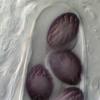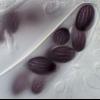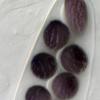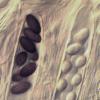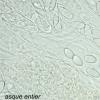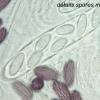
09-12-2025 12:06
 Andgelo Mombert
Andgelo Mombert
Bonjour,Je recherche l'article concernant Hypobryo

07-12-2025 16:07
Arnold BüschlenHallo, ich habe in einer Moos-Aufsammlung (epiphy

08-12-2025 21:04
Mark Stevens"Hello everyone,I'm relatively new to microscopy (

08-12-2025 18:59
 Lothar Krieglsteiner
Lothar Krieglsteiner
.. found by a seminar-participant, I do not know t

08-12-2025 17:37
 Lothar Krieglsteiner
Lothar Krieglsteiner
20.6.25, on branch of Abies infected and thickened

16-03-2014 22:00
Hello,I found this species a few months ago but ha

08-12-2025 13:39
Thomas Læssøehttps://svampe.databasen.org/observations/10572899
 Bonsoir à tous
Bonsoir à touswhile studying ascospore ornamention in a collection of Ascobolus furfuraceus I noticed something which was happening in a considerable number of asci. The ascospores were arranging themselves such that their respective gelatinous sheaths were aligned to form a continuous sinuous connection along their lengths; the accompanying images show what I mean.
I wonder whether others have noticed this phenomenon in this or in other Ascobolus species?
Cordialement
Chris


Van Brummelen says:
"ARRANGEMENT OF ASCOSPORES. — In Ascobolus the spores are mutually free.
At first they are usually arranged in a single row . But when the ascus stretches there
often becomes space available for a double row of longitudinally disposed spores or
a single row of obliquely disposed ones. Sometimes the very thick, mucilaginous
substance adhering to the spores prevents the formation of a double row . . . .
. . . . . The spores are never regularly arranged, according to a fixed pattern,
in Ascobolus." [my underlining].
To be fair I think he intends to stress the difference in which the spore-balls of Saccobolus follow a very strict pattern (or rather patterns), consistent within a species, as they are formed.
I agree that this is a secondary character and that the true function of the gel is as Zotto suggests.
regards
Chris


I also found this trait on other species such as Ascobolus Ascobolus saccariferus. As against this character is not always present because often the spores are not ordered in the asci and are also not mature. This character is also I think in some asci ephemeral and persistent in others.
Regards.
Michel.

the arrangement in the living immature asci on your two pics i would estimate as rather regular. The middle of the three immature asci on pic 1 is turgorless, irreversibly as I think. The gel sheath usually inflates when the turor is released but it has a semipermeable membrane and could keep the shape for a while. Your asci with mature spores are all dead, therefore the arrangement is more variable.

